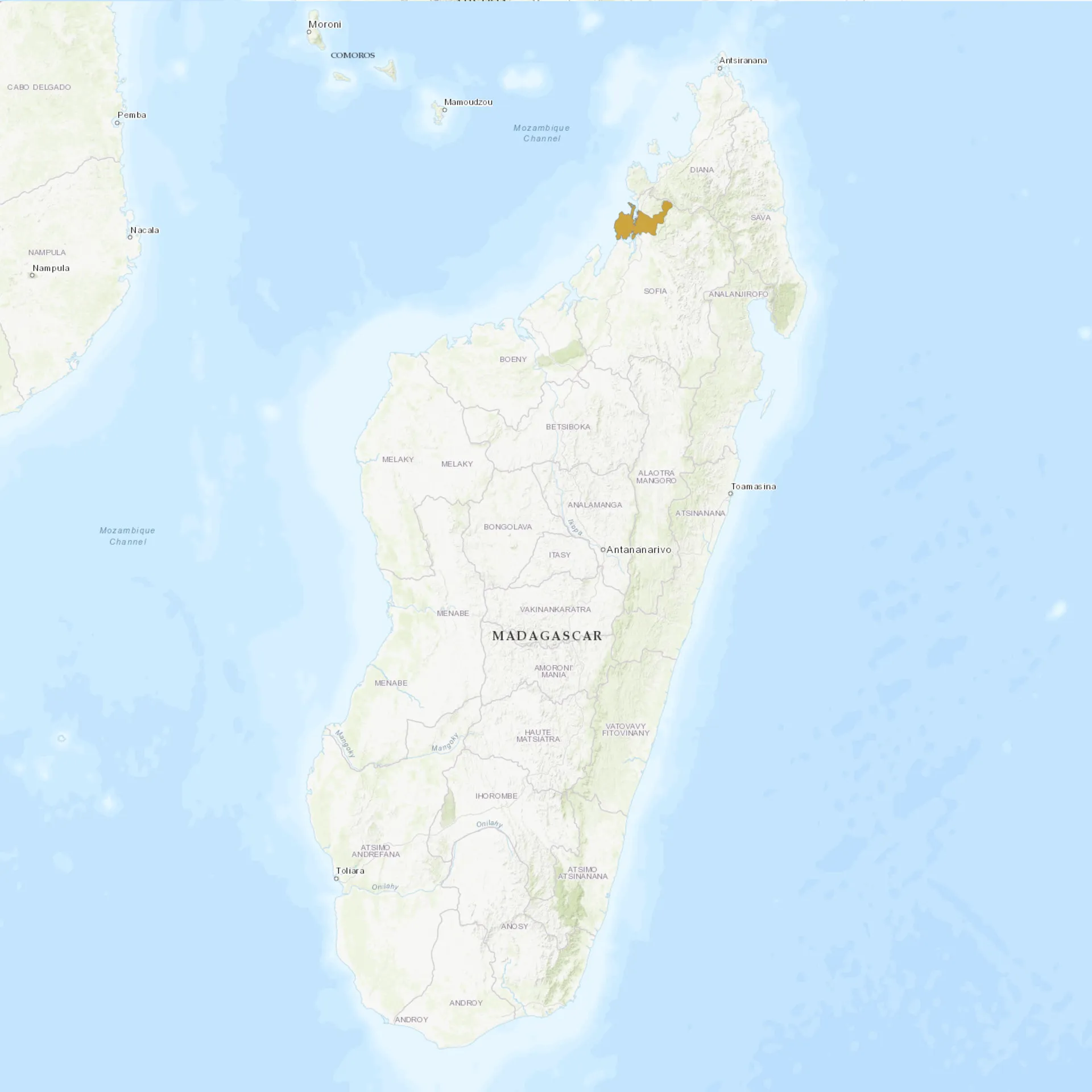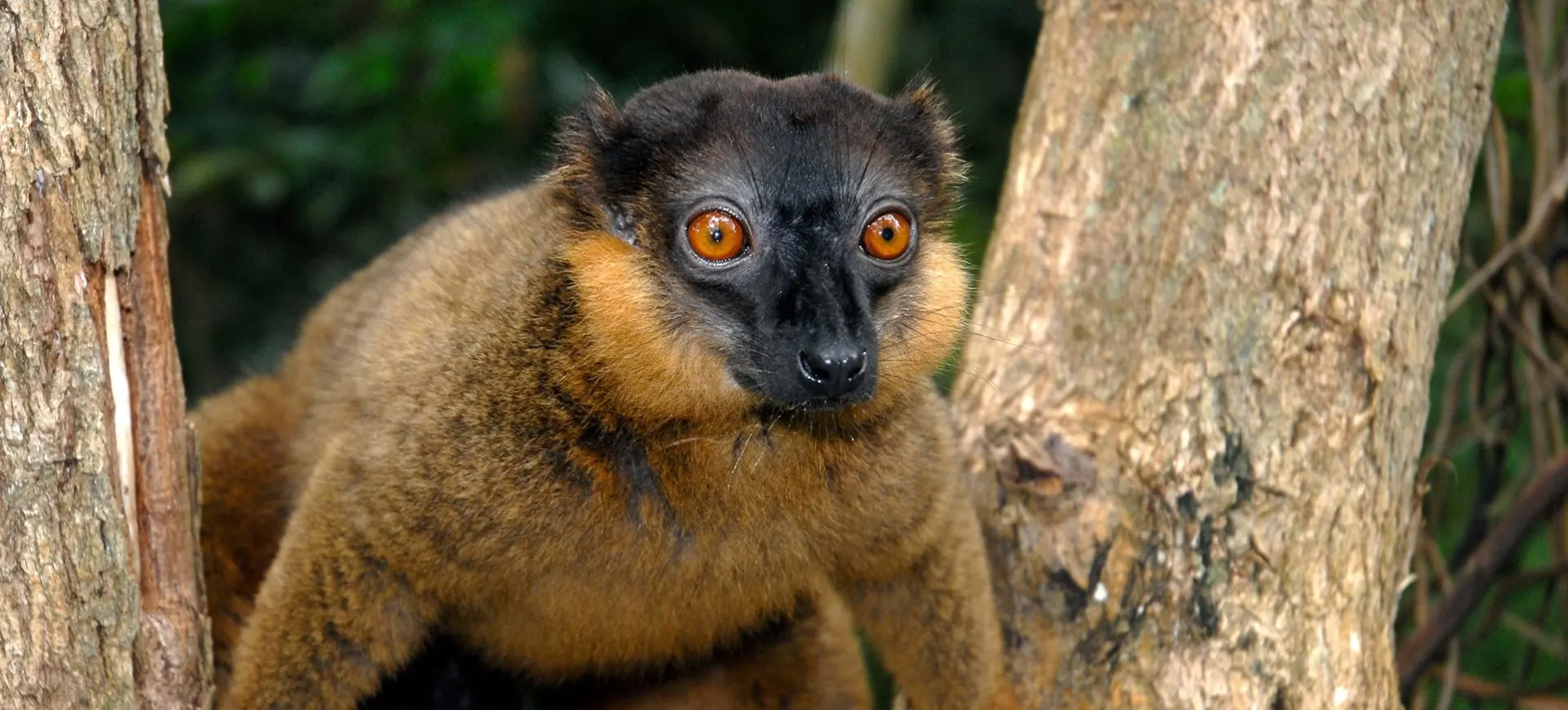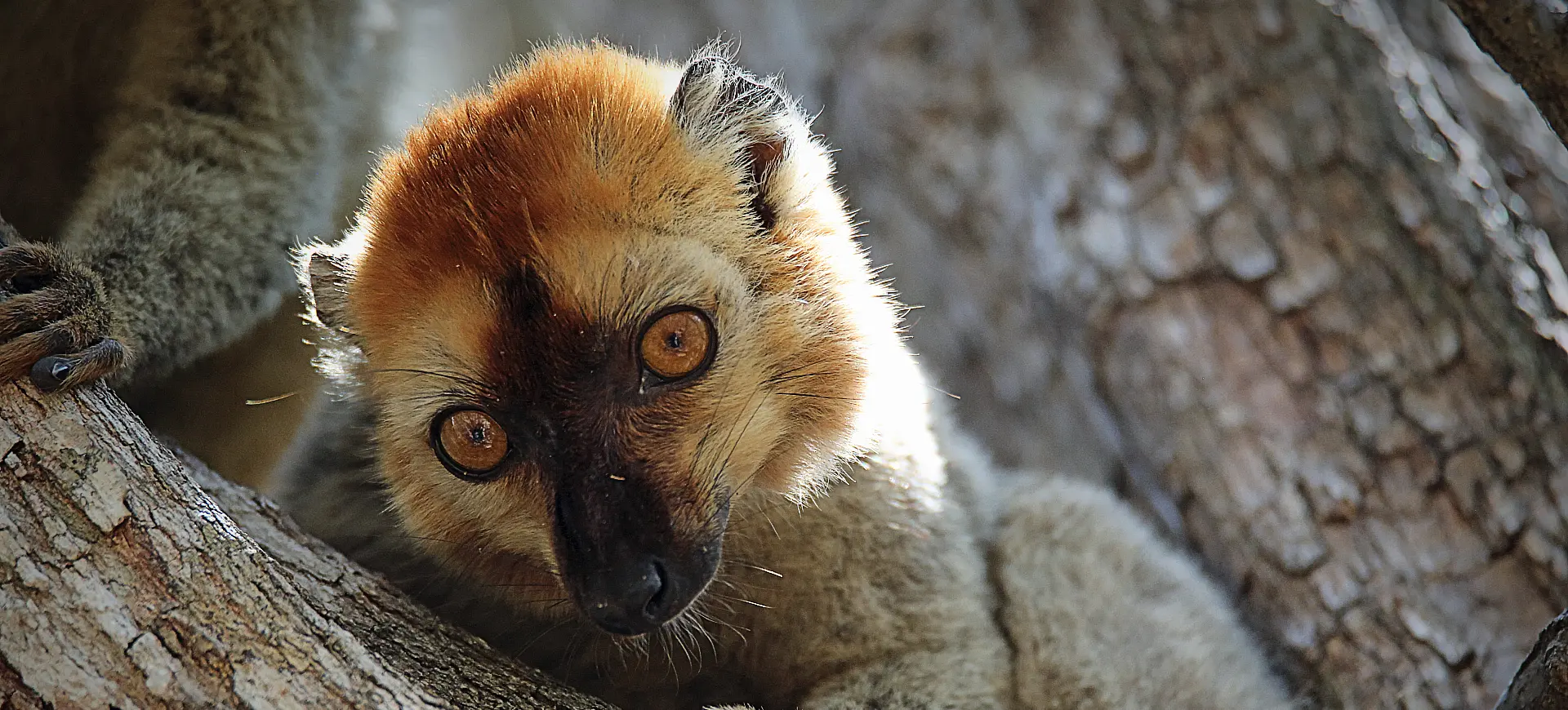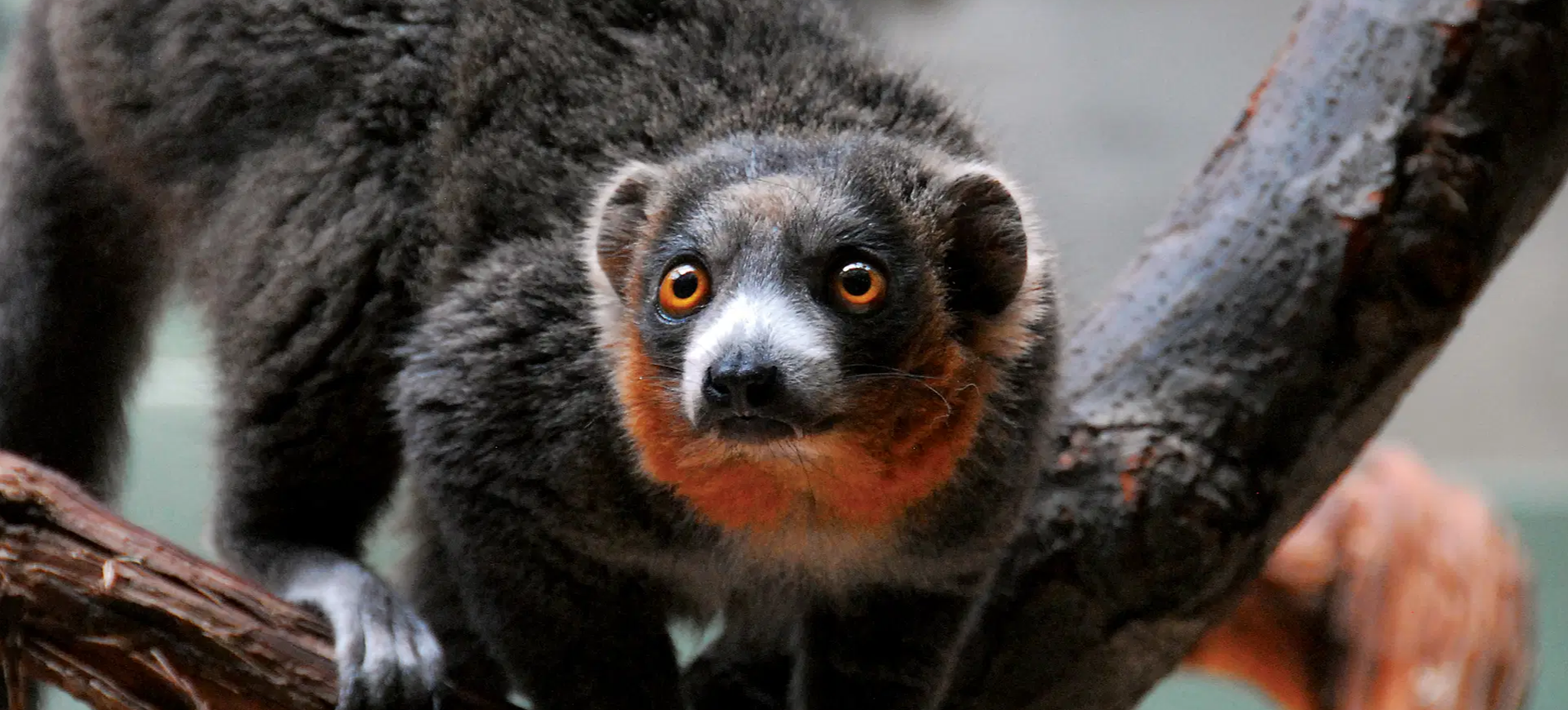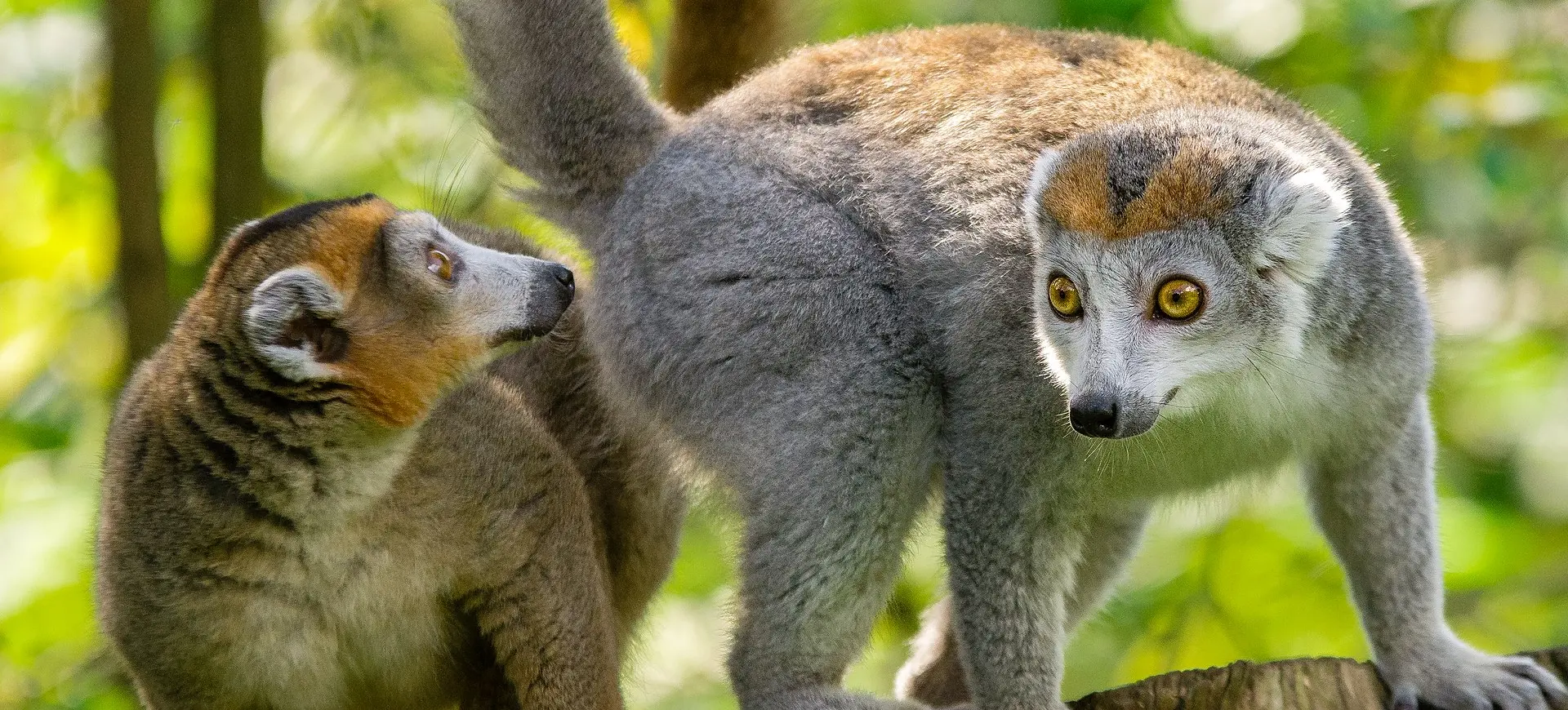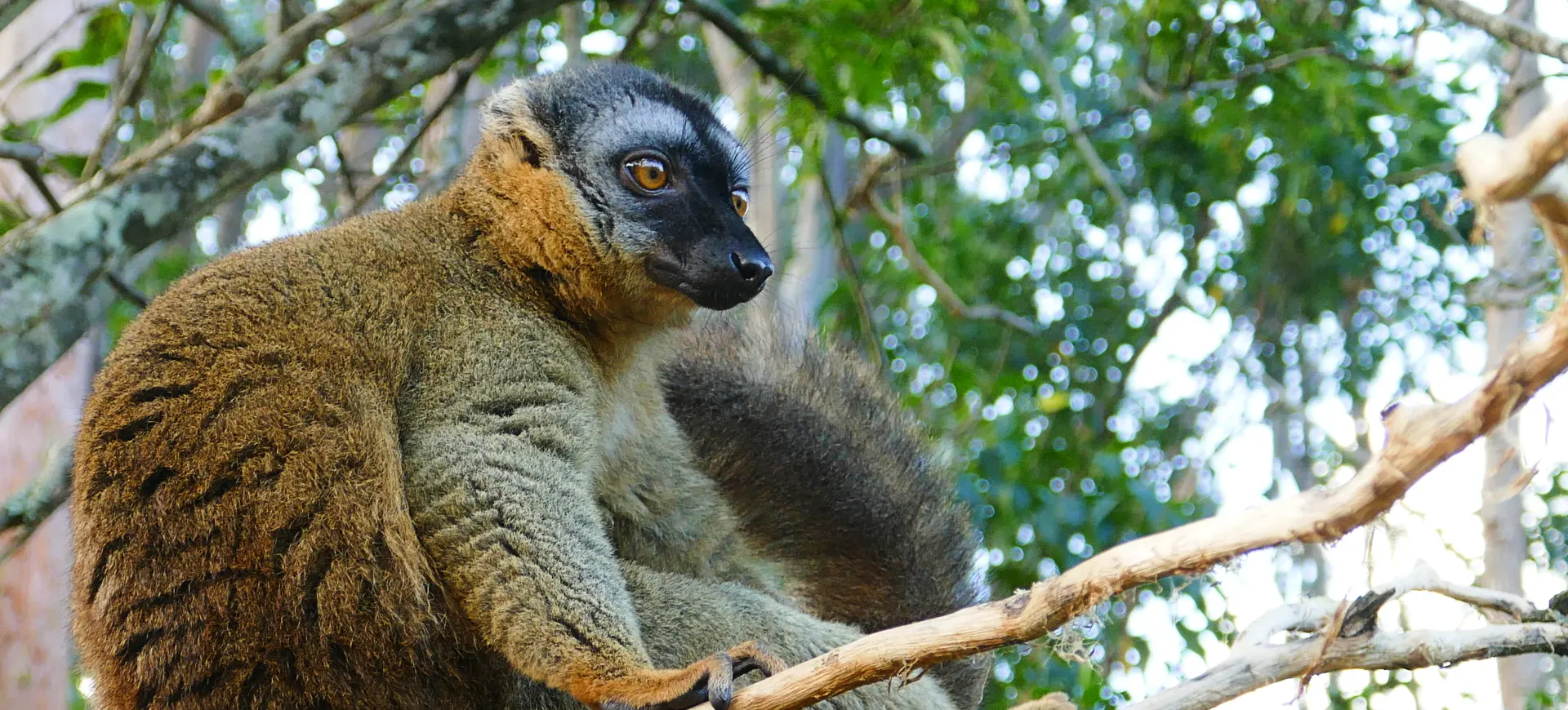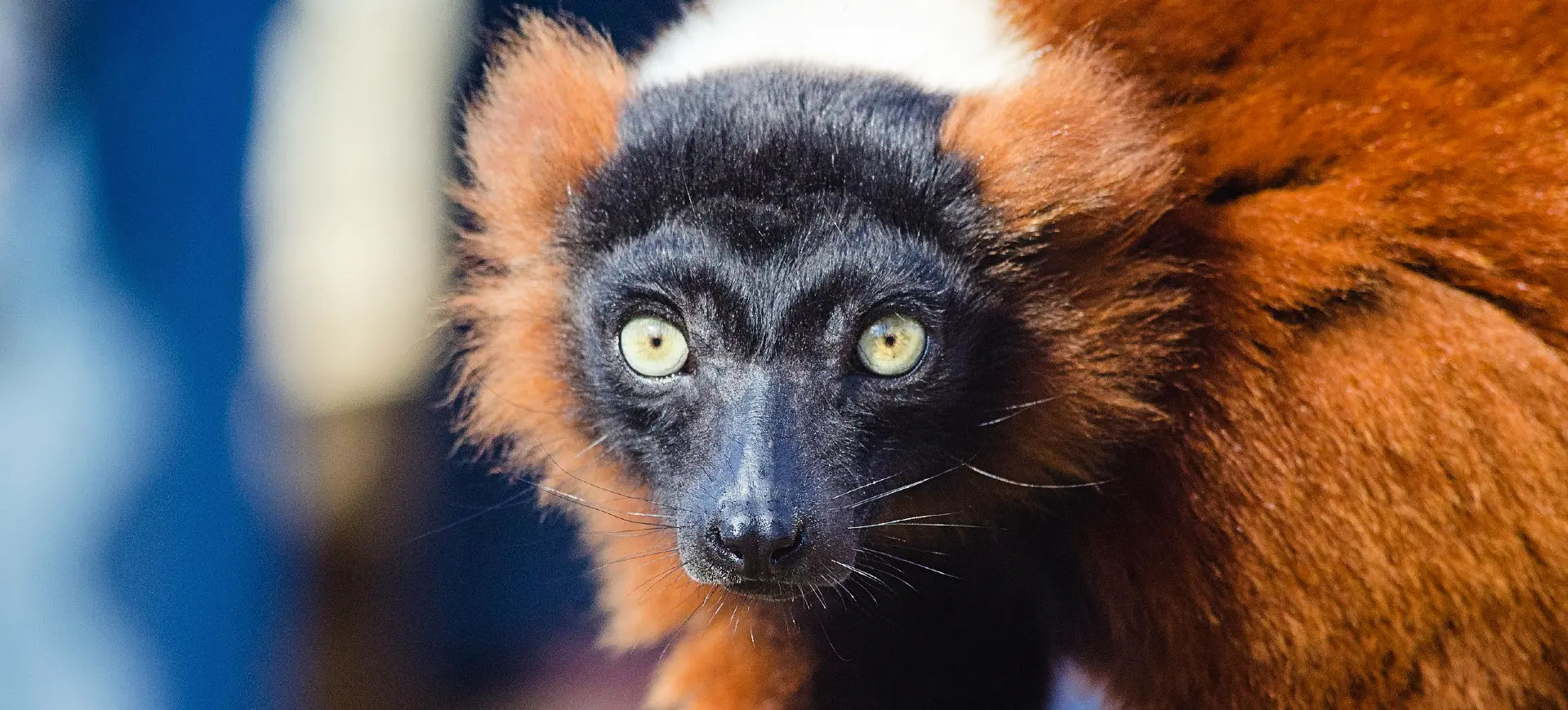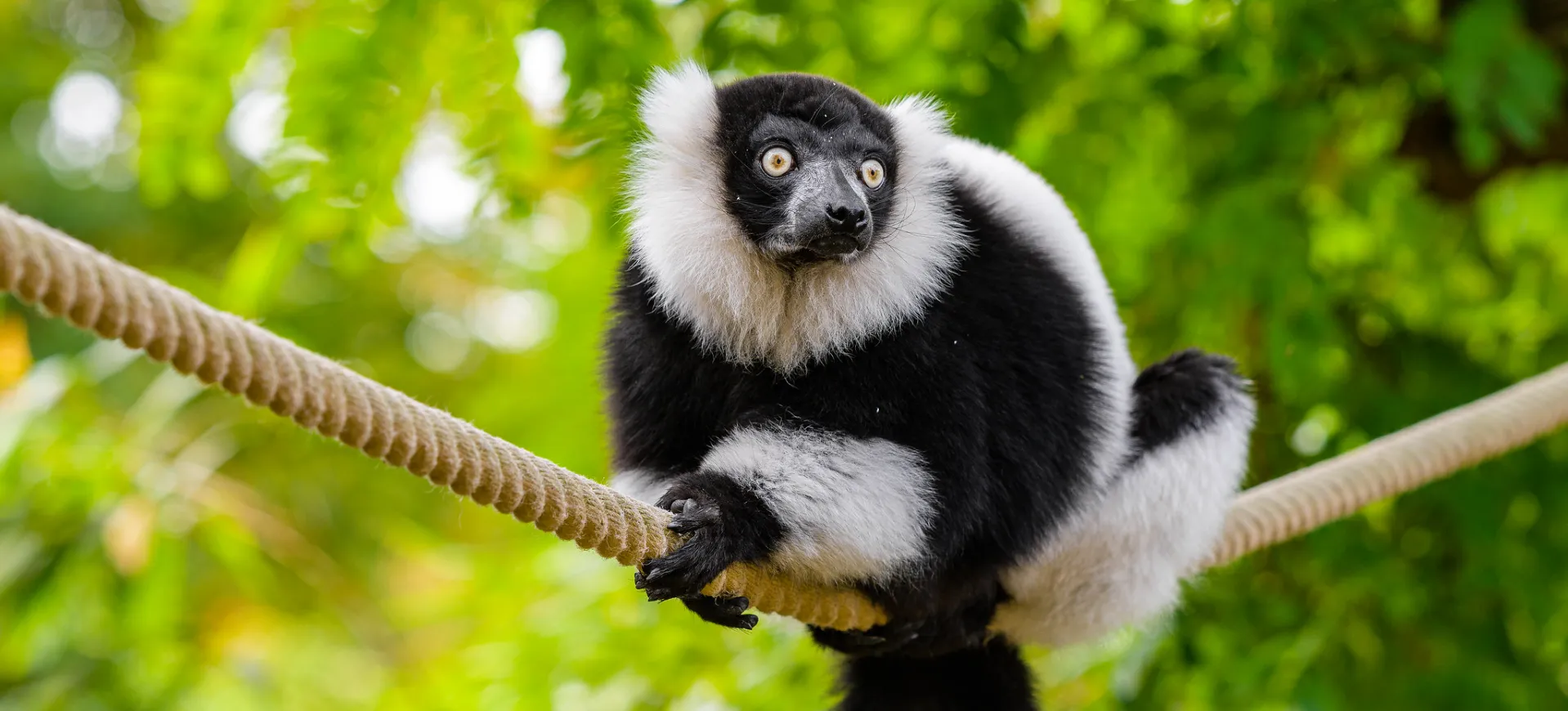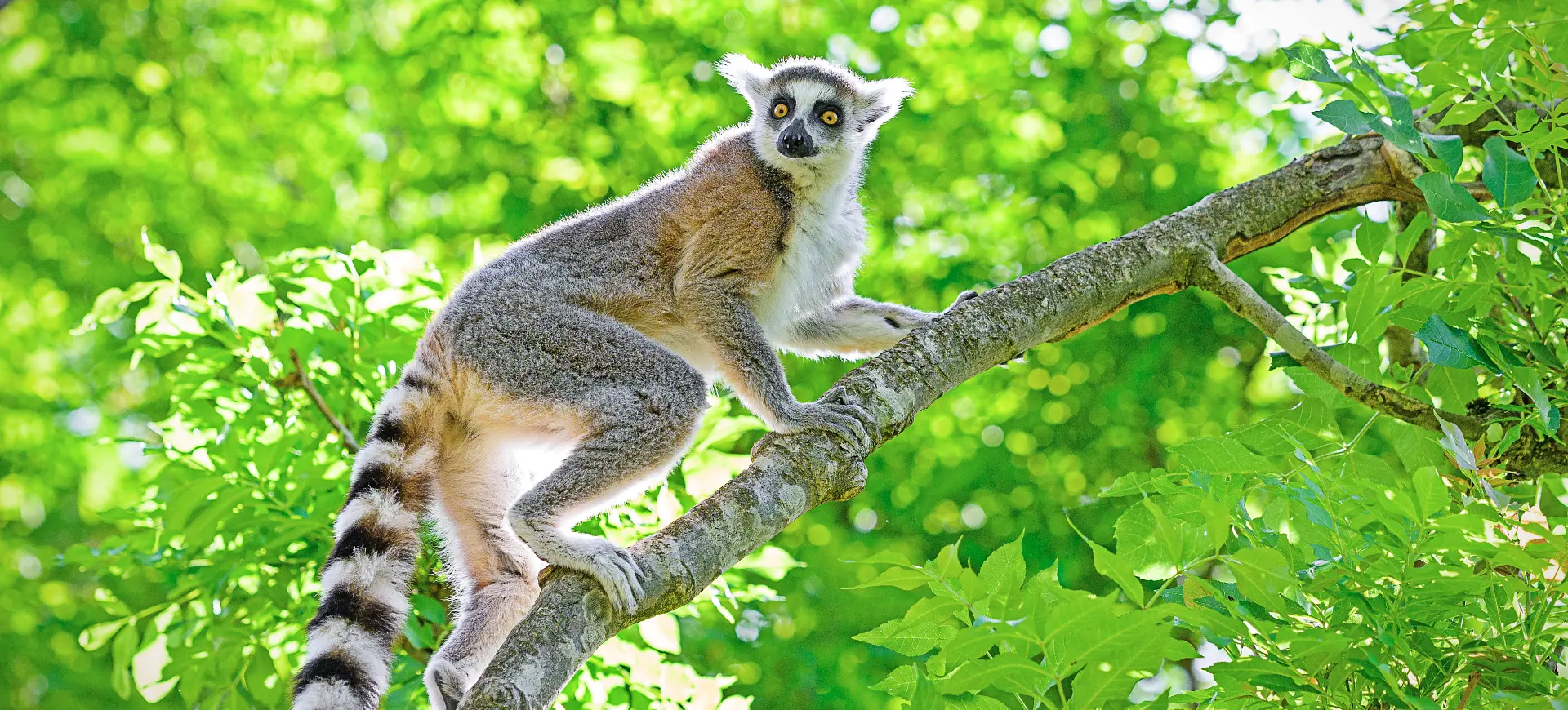Overview
The blue-eyed black lemur (Eulemur flavifrons) is a rare and striking primate native to Madagascar, distinguished by its unique blue eyes—a trait uncommon among primates. Males have black fur, while females display a rich reddish-brown coat, creating a stark sexual dimorphism. This species is arboreal and primarily inhabits dense tropical forests, using its long tail for balance as it moves through the treetops. It is a highly social animal, living in small groups with a complex communication system involving vocalizations, scent marking, and body language.
The blue-eyed black lemur is primarily active during the day but exhibits cathemeral behavior, meaning it can also be active at night, depending on food availability and environmental factors. Its diet consists mainly of fruits, flowers, nectar, and leaves, making it an important seed disperser within its habitat. Due to its restricted range and dependence on intact forests, the species is highly susceptible to habitat destruction. As a result, it is classified as critically endangered and faces ongoing population decline.
This lemur plays a crucial role in Madagascar’s ecosystem, particularly in pollination and maintaining forest biodiversity. Despite its adaptability in feeding habits, it struggles with habitat fragmentation caused by agriculture, logging, and human settlements. Conservation programs, including captive breeding and habitat protection, aim to prevent its extinction. However, the illegal pet trade and hunting pose significant threats, making conservation efforts increasingly urgent.
Current distribution:
The Blue-Eyed Black Lemur's distribution is restricted to the northwestern part of Madagascar, specifically within the Sambirano region and adjacent areas. This limited range makes the species particularly susceptible to habitat degradation and loss. Human activities have fragmented their habitat, making isolated populations more vulnerable to extinction. Protected areas within their range, such as the Ankarana and Lokobe reserves, provide crucial refuges for these lemurs, supporting conservation efforts to maintain viable populations in the wild.
Despite these protected areas, the overall distribution of the Blue-Eyed Black Lemur continues to shrink, underscoring the urgency of conservation measures. Efforts to expand the network of protected habitats and reforestation and habitat connectivity projects are essential for ensuring the species' survival. Monitoring and research are also critical for understanding the dynamics of their populations and the effectiveness of conservation interventions, providing the basis for adaptive management strategies that can respond to changing threats and conservation challenges.
Physical Description:
The Blue-Eyed Black Lemur is notable for its striking blue eyes, a rare feature among non-human primates, setting it apart from other lemur species. This lemur exhibits significant sexual dimorphism; males have a completely black or dark brown fur coat, while females sport a lighter, reddish-brown fur, making the two sexes easily distinguishable. Both sexes have a similar size and build, with strong, agile bodies adapted for an arboreal lifestyle, enabling them to easily navigate through the forest canopy. Their long, bushy tails, which can be as long as their bodies, are not prehensile but serve as a balance aid when leaping between trees and as a visual signal in social interactions.
The Blue-Eyed Black Lemur’s physical adaptations, including powerful hind limbs and opposable thumbs, facilitate its movement through the dense forests of Madagascar, its native habitat. These adaptations allow for efficient foraging and evasion from predators, critical for their survival in the wild. The blue-eyed black lemur’s forward-facing eyes provide a wide field of binocular vision, essential for accurately judging distances during their frequent and agile arboreal movements. Their hands and feet are equipped with tactile pads, enhancing their grip on tree branches and supporting their active, tree-dwelling lifestyle.

Lifespan: Wild: Unknown || Captivity: ~30 Years

Weight: Male: 4.9–5.5 lbs (2.2–2.5 kg) || Female: 4.4–5.3 lbs (2.0–2.4 kg)

Length: Male & Female: Body 15.7-17.7 in (40-45 cm) || Tail 19.7-22 in (50-56 cm)

Top Speed: 12 mph (19 km/h)
Characteristic:
Native Habitat:
The Blue-Eyed Black Lemur is endemic to the Sambirano region of northwestern Madagascar, a unique ecosystem characterized by its tropical moist forests. This habitat provides the dense canopy cover and diverse fruiting trees essential for the lemur’s survival, offering food and shelter. Their habitat preferences reflect the need for continuous forest coverage that supports their arboreal lifestyle and foraging habits. The lemur’s range is limited to a relatively small area, making it particularly vulnerable to habitat loss and fragmentation.
Conservation of their natural habitat is critical, as the Sambirano region faces increasing pressure from agricultural expansion, logging, and mining. Efforts to protect and restore these forested areas are vital for the survival of the Blue-Eyed Black Lemur, highlighting the need for integrated conservation strategies that involve local communities. Establishing protected areas and promoting sustainable land use practices are key components of these strategies, aimed at preserving the region’s unique biodiversity and ensuring the long-term viability of this remarkable lemur species.
Climate Zones:
Biomes:
WWF Biomes:
Biogeographical Realms:
Continents:
Countries:
Diet:
Diet & Feeding Habits:
The Blue-Eyed Black Lemur is an omnivore with a diet consisting primarily of fruits, leaves, and flowers, supplemented by insects and small invertebrates. This varied diet reflects the lemur’s ability to adapt to the seasonal availability of food resources within its forest habitat. During the rainy season, when fruits are abundant, they form the bulk of the diet, providing essential nutrients and energy. In contrast, during the dry season, leaves and flowers become more important, demonstrating the lemur’s flexibility in foraging strategies to cope with changing environmental conditions.
Their feeding behavior is characterized by foraging in the canopy, where they utilize their agile movements and keen sense of smell to locate food. Social foraging is common, with group members communicating about food locations and sharing resources. The Blue-Eyed Black Lemur’s role as a seed disperser is crucial for regenerating their forest habitat, highlighting the interdependence between this species and its ecosystem. Conservation efforts that focus on preserving their natural habitat and food sources are essential for the survival of this species, emphasizing the importance of sustainable forest management practices in Madagascar.
Mating Behavior:
Mating Description:
The Blue-Eyed Black Lemur uses a polygamous mating system, where males and females may have multiple mating partners throughout the breeding season. This behavior increases genetic diversity within their populations and leads to competitive behaviors among males for receptive females. Mating season is a critical time for these lemurs, occurring between April and May when resources are becoming more abundant and the forest is lush, providing an optimal environment for raising offspring. Females typically give birth to one or two offspring after a gestation period of approximately 120 to 129 days, with births peaking from August to September, coinciding with the end of the dry season and the onset of the rainy season when food availability increases.
The Blue-Eyed Black Lemur exhibits considerable parental care, with females primarily responsible for nurturing and protecting their young. Newborns are highly dependent on their mothers for warmth, protection, and nutrition during the initial stages of their lives. As part of their social structure, other group members, including older offspring and sometimes males, may participate in alloparenting, helping to carry and groom the infants, strengthening social bonds within the troop. The early life of these lemurs is crucial for developing the necessary skills for survival, such as foraging and social interaction, under the careful guidance of their mothers and other group members.
Reproduction Season:
Birth Type:
Pregnancy Duration:
Female Name:
Male Name:
Baby Name:
Social Structure Description:
The Blue-Eyed Black Lemur lives in social groups that typically consist of 2 to 15 individuals, including a mix of males and females. These groups are organized into complex social hierarchies, where rank can influence access to resources and mating opportunities. Social interactions within the group are vital for maintaining cohesion, with grooming playing a key role in reinforcing social bonds and reducing stress. Vocalizations, facial expressions, and body postures are used extensively for communication, helping to coordinate group activities and maintain group cohesion.
Territorial behavior is observed, with groups defending their home ranges through vocal displays and scent marking. The size and composition of groups can fluctuate based on habitat quality and population density. Alloparenting, where individuals other than the biological parents care for the young, is common, highlighting the cooperative nature of their social system. The social structure of the Blue-Eyed Black Lemur facilitates efficient foraging, predator avoidance, and the rearing of offspring, reflecting the species’ adaptation to its environment and the importance of social bonds for survival.
Groups:
Conservation Status:
Population Trend:
The population of the Blue-Eyed Black Lemur is critically low, primarily due to habitat loss, fragmentation, and hunting. Their restricted range in the Sambirano region of Madagascar, combined with the rapid rate of deforestation and human encroachment, has led to significant declines in their numbers. Conservationists estimate that without immediate and effective conservation action, this species faces an imminent risk of extinction in the wild. Efforts to monitor and protect the remaining populations are hindered by their habitat’s remote and inaccessible nature, emphasizing the need for increased conservation funding and resources.
Despite these challenges, there are glimmers of hope, with some populations showing resilience in protected areas and reserves. These areas provide a critical refuge for the Blue-Eyed Black Lemur, offering protection from habitat destruction and hunting. Conservation strategies focusing on habitat protection, restoration, and community engagement are essential for stabilizing and potentially increasing their populations. Education and awareness programs aimed at reducing hunting and promoting sustainable land use practices are also critical for ensuring the long-term survival of this species.
Population Threats:
The primary threats to the Blue-Eyed Black Lemur include habitat destruction due to slash-and-burn agriculture, illegal logging, and the expansion of mining activities. These activities lead to significant habitat fragmentation, reducing the availability of food and shelter and isolating populations, which decreases genetic diversity and increases vulnerability to extinction. Illegal hunting for bushmeat and the pet trade further exacerbates the decline of this species despite legal protections. Climate change poses an additional threat, potentially altering the Sambirano region’s ecosystems and impacting the lemurs’ availability of food resources.
To address these threats, conservation efforts must prioritize protecting the Blue-Eyed Black Lemur’s habitat through creating and enforcing protected areas, reforestation, and habitat connectivity initiatives. Anti-poaching measures and the strict enforcement of wildlife trade regulations are also crucial for reducing direct threats to the species. Collaboration with local communities is essential for developing sustainable alternatives to activities that harm lemurs and their habitat, ensuring the effectiveness of conservation measures and the long-term viability of the Blue-Eyed Black Lemur populations.
Conservation Efforts:
The Blue-Eyed Black Lemur’s conservation efforts focus on habitat protection, restoration, and creating ecological corridors to connect fragmented populations. These efforts include establishing and managing protected areas within the species’ range, which are crucial for preserving their natural habitat. Reforestation projects aim to restore degraded areas, enhancing habitat quality and connectivity. Conservation organizations are also working to increase local and global awareness of the plight of the Blue-Eyed Black Lemur, promoting conservation education and community engagement initiatives.
Collaborative efforts with local communities are key to the success of conservation strategies, involving them in habitat protection and sustainable development projects that benefit humans and wildlife. Anti-poaching patrols and wildlife law enforcement activities are being strengthened to combat illegal hunting and the pet trade. Conservation breeding programs, although limited, play a role in maintaining genetic diversity and may support future reintroduction efforts. International support and funding are vital for expanding these conservation efforts, ensuring that the Blue-Eyed Black Lemur can be saved from the brink of extinction.
Additional Resources:
Fun Facts
- The Blue-Eyed Black Lemur is one of the few primate species with blue eyes, a trait rarely seen outside humans.
- Their varied diet changes with the seasons, demonstrating their adaptability to different food resources.
- This lemur species can consume certain toxic plants thanks to a unique digestive system that neutralizes toxins.
- Females are the dominant sex in their social structure, a trait common among many lemur species.
- They use a wide range of vocalizations to communicate, including alarm calls that vary depending on the type of predator.
- The Blue-Eyed Black Lemur is known for its remarkable jumping ability. It can leap distances of over 10 meters between trees.
- They play a crucial role in their ecosystem as seed dispersers, aiding in the regeneration of their forest habitat.
- Infants are born with their eyes open and are highly dependent on their mothers for the first few months of life.
- Their tail is used for balance and communication but is not prehensile.
- The Blue-Eyed Black Lemur’s striking appearance and ecological importance make it a flagship species for Madagascar’s conservation efforts.


